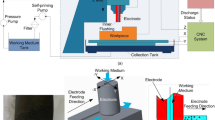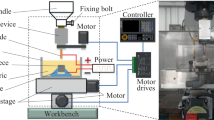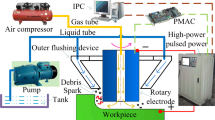Abstract
Fast electrical discharge milling (fast ED-milling) has become a promising technology in the manufacturing industry for machining complex structures such as diffuser-shaped film cooling holes. However, the mechanism of the efficient removal of materials in this technology is not yet fully understood. To gain a further insight into this matter, an experimental investigation on the morphology of discharge craters including the absolute material removal volume per discharge, material residual volume per discharge, and directionality, is firstly carried out. The obtained results imply that a high-pressure inner flushing can significantly promote the expelling of molten material from a molten pool and is a fundamental reason why fast ED-milling can be of higher machining efficiency than regular ED-milling. To explore the mechanism behind, a novel thermal-fluid coupling model is developed to simulate the evolution process of the molten material under the effect of a flow field. The results of numerical simulation show that during a discharging, the molten material moves along the workpiece surface towards the outlet of a gap channel and solidifies at the side of a crater that is away from the electrode center. Another interesting finding is that an inappropriately high flushing pressure can result in a low machining efficiency because the severe heat convection will consume a large part of the heat generated by a discharge. This well explains the phenomenon that occurred during the experimental investigation.
























Similar content being viewed by others
Availability of data and materials
The datasets used or analyzed during the current study are available from the corresponding author on reasonable request.
Code availability
This paper uses a proprietary software and will be not available.
References
Yu Z, Masuzawa T, Fujino M (1998) Micro-EDM for three-dimensional cavities-development of uniform wear method. CIRP Ann 47(1):169–172
Bellotti M, Caballero JRDE, Qian J, Reynaerts D (2021) Effects of partial tool engagement in micro-EDM milling and adaptive tool wear compensation strategy for efficient milling of inclined surfaces. J Mater Process Technol 288:116852
Pei J, Liu Y, Zhu Y, Zhang L, Zhuang X, Wu S (2018) Machining strategy and key problems for 3D structure of micro-EDM by fix-length compensation method with tubular electrodes. Procedia CIRP 68:802–807
Huang H, Bai J-C, Lu Z-S, Guo Y-F (2009) Electrode wear prediction in milling electrical discharge machining based on radial basis function neural network. J Shanghai Jiaotong Univ (Science) 14(6):736–741
Kliuev M, Boccadoro M, Perez R, Dal Bó W, Stirnimann J, Kuster F, Wegener K (2016) EDM drilling and shaping of cooling holes in Inconel 718 turbine blades. Procedia CIRP 42:322–327
Kliuev M, Wegener K (2020) Method of machining diffusors in Inconel 718 turbine blades for film cooling using EDM drilling and shaping. Procedia CIRP 95:511–515
Kliuev M, Kutin A, Wegener K (2021) Electrode wear pattern during EDM milling of Inconel 718. Int J Adv Manuf Technol 117(7):2369–2375
Xia W, Zhang Y, Chen M, Zhao W (2020) Study on gap phenomena before and after the breakout event of fast electrical discharge machining drilling. J Manuf Sci Eng-Trans ASME 142(4):041004
Zhang Y, Liu Y, Shen Y, Ji R, Li Z, Zheng C (2014) Investigation on the influence of the dielectrics on the material removal characteristics of EDM. J Mater Process Technol 214(5):1052–1061
Chu H, Xi X, Li Z, Zhang Y, Zhao W (2021) Study on the evolution process of recast layer for fast EDM drilling based on observation experiment and a novel thermal-fluid coupling model. J Phys D Appl Phys 54(32):325501
Zhu Y, Gu L, Farhadi A, He G, Zhao W (2019) Observation and analyzation of plasma channel evolution behavior in air flushing electrical arc machining. Int J Adv Manuf Technol 100(9):3127–3138
Yue X, Yang X, Li Q, Li X (2020) Novel methods for high-speed observation of material removal and molten pool movement in EDM. Prec Eng 66:295–305
Zhang F, Gu L, Chen J, Xu H, Zhao W (2016) Observation and modeling research of high-velocity flushing effect on the performance of BEAM. Int J Adv Manuf Technol 86(1):935–942
Natsu W, Ojima S, Kobayashi T, Kunieda M (2004) Temperature distribution measurement in EDM arc plasma using spectroscopy. JSME Int J Ser C 47(1):384–390
Kitamura T, Kunieda M, Abe K (2015) Observation of relationship between bubbles and discharge locations in EDM using transparent electrodes. Prec Eng 40:26–32
Tang J, Yang X (2017) A novel thermo-hydraulic coupling model to investigate the crater formation in electrical discharge machining. J Phys D Appl Phys 50(36):365301
Tang J, Yang X (2018) Simulation investigation of thermal phase transformation and residual stress in single pulse EDM of Ti–6Al–4V. J Phys D Appl Phys 51(13):135308
Li Z, Bai J, Tang J (2018) Experimental investigation on the discharge stability in micro-EDM based on finite-successive pulses discharge method. J Phys D Appl Phys 51(47):475104
Descoeudres A, Hollenstein C, Wälder G, Perez R (2005) Time-resolved imaging and spatially-resolved spectroscopy of electrical discharge machining plasma. J Phys D Appl Phys 38(22):4066
Kojima A (2007) Observation of arc plasma expansion and delayed growth of discharge crater in EDM. Proc ISEM 1–4
Kojima A, Natsu W, Kunieda M (2008) Spectroscopic measurement of arc plasma diameter in EDM. CIRP Ann 57(1):203–207
Xia H, Kunieda M, Nishiwaki N (1996) Removal amount difference between anode and cathode in EDM process. Ijem 1:45–52
Quested PN, Brooks RF, Chapman L, Morrell R, Youssef Y, Mills KC (2009) Measurement and estimation of thermophysical properties of nickel based superalloys. Mater Sci Technol 25(2):154–162
Osher S, Sethian JA (1988) Fronts propagating with curvature-dependent speed: algorithms based on Hamilton-Jacobi formulations. J Comput Phys 79(1):12–49
Acknowledgements
The authors thank Dr. Xiao-Lei Yu, who provided valuable feedback on early drafts of this work.
Funding
This work is financially supported by the National Natural Science Foundation of China (No. 52075333, 52175426), and the National Science and Technology Major Projects of China (No. 2018ZX04005001).
Author information
Authors and Affiliations
Contributions
Jian Wang: methodology, conceptualization, software, validation, formal analysis, writing — original draft and editing. Xue-Cheng Xi: funding acquisition, supervision, reviewing and editing. Hao-Yu Chu: formal analysis, software, validation. Ya-Ou Zhang: formal analysis, validation. Fu-Chun Zhao: validation. Wan-Sheng Zhao: funding acquisition, supervision, reviewing and editing.
Corresponding author
Ethics declarations
Ethics approval and consent to participate
Not applicable.
Consent for publication
Not applicable.
Competing interests
The authors declare no competing interests.
Additional information
Publisher's note
Springer Nature remains neutral with regard to jurisdictional claims in published maps and institutional affiliations.
Rights and permissions
About this article
Cite this article
Wang, J., Xi, XC., Chu, HY. et al. Experimental and numerical investigation into material removal mechanism of fast ED-milling. Int J Adv Manuf Technol 121, 4885–4904 (2022). https://doi.org/10.1007/s00170-022-09673-4
Received:
Accepted:
Published:
Issue Date:
DOI: https://doi.org/10.1007/s00170-022-09673-4




